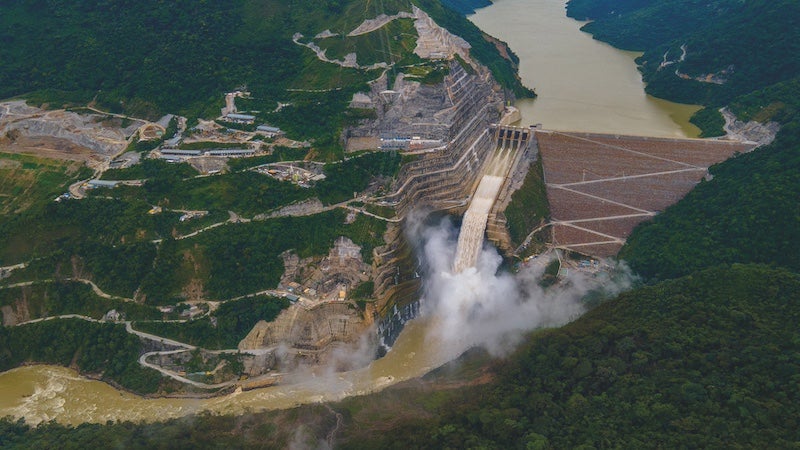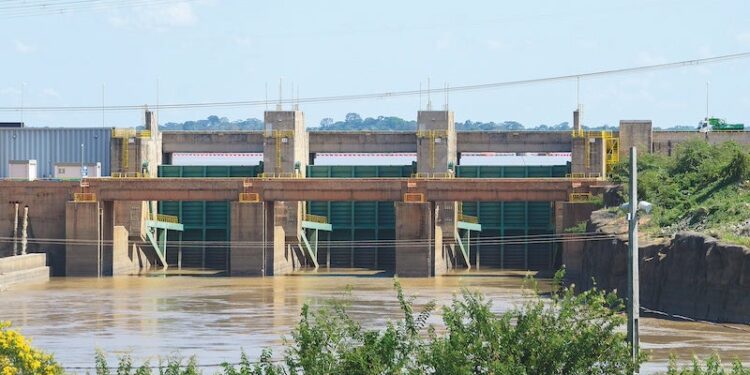Santo Antonio hydroelectric project on the Madeira River in Brazil. Hydropower operations were halted temporarily in 2023 due to low reservoir levels caused by drought. Southern American hydropower has to increase its resilience to climate change
© Vinicius Bacarin / Shutterstock.com
Providing 45% of electricity supply in South America, hydropower stands “as a cornerstone of the region’s energy infrastructure”, the International Hydropower Association reports in its 2024 World Hydropower Outlook. With total hydro generation reaching 728TWh in 2023, an increase of around 16TWh from 2022, the IHA says it remained a “robust source of energy throughout the year”, despite drought conditions causing a temporary drop in generation in the first half.
Challenges faced by South America last year have highlighted the need for greater resilience in hydropower infrastructure in the face of climate change. As Uruguay’s worst drought for over 70 years impacted several hydropower reservoirs, Brazil also had to temporarily halt hydropower operations at the 3568MW Santo Antonio plant due to low water levels. The IHA says that investing in the modernisation of ageing hydropower plants across the continent, where more than 50% of installed capacity is over 30 years old, will increase climate change resilience and ensure hydropower continues to play a key role in energy production here.
Foreign direct investment (FDI) in the hydropower sector in South America is also reported to have declined in recent years. From 2005 to 2022, the IHA says hydro only attracted 4% of total FDI in the renewable energy sector, despite considerable Chinese investment where, for example, Chinese firms acquired stakes in 304 Brazilian hydropower plants, equal to 10% of the country’s national energy generation capacity. Bolivia, Brazil, Ecuador and Peru have also received significant Chinese investment.
As the IHA report states, investor hesitancy due to environmental and social concerns associated with large-scale hydropower initiatives is one of the factors associated with such a decline. In addition, the investment landscape has been further complicated by the evolving challenges posed by climate change – such as shifting rainfall patterns and prolonged droughts. Innovative regulatory frameworks are needed to address these and to ensure they no longer act as a deterrent to potential investors from committing to long-term projects.
Argentina
Looking across the region, Argentina, along with an increasing number of other countries in South America, is facing up to the challenge of renewing hydropower agreements that are set to expire in the next five years. Four Argentine hydropower projects, equating to 4380MW or 42% of the nation’s total hydropower capacity, faced contract termination in late 2023. Although the country’s Secretary of Energy granted an extension for these it raised concern about future operational continuity.
As the IHA report states: “The uncertainty regarding the government’s next steps – whether to reassume control or initiate new concession bidding – adds complexity to ensuring sustained energy infrastructure reliability.”
Other big news from Argentina is that the 750MW Río Grande de Córdoba plant, the region’s largest pumped storage project, is set for a major upgrade. Currently operating at only 50% efficiency due to ageing infrastructure, a US$100 million investment aims to modernise the facility, restoring its full operational potential. In addition, the 1310MW Santa Cruz River hydropower development has reached 50% of construction progress. This large-scale, almost US$5 billion investment is 70% financed by the China Gezhouba Group Company Limited, in partnership with Argentine firms.
Currently only utilising about 20% of its estimated hydropower potential, to help support further development, Argentina has implemented several policies and incentives including feed-in tariffs and PPAs specially targeting small hydro schemes up to 30MW.
Bolivia
Another country in South America to watch, according to the IHA, is Bolivia. Currently only using around 2% of its estimated hydropower potential, with 80% of untapped capacity located in very remote areas, it has a project pipeline that included the 3000MW binational Rio Maderia project, along with several medium and small-scale ones already. Underway.
Bolivia is prioritising large-scale projects through state-owned utilities. Several schemes soon due for completion include the 292MW Ivirizu cascade project which is expected to swing into full operation by March 2025, plus the Miguillas hydropower complex. Comprising the 86MW Umapalca and119MW Palillada plants, these have anticipated completion dates of October 2025 and December 2026 respectively.
Brazil
Hydropower contributed to 67% of Brazilian electricity generation in 2023 and numerous small hydro projects were connected to the grid. Adding a total of 118MW in installed capacity, these brought the total number of operating projects in the country to 1330.
Looking at larger schemes, 34 projects totalling 438MW are in advanced construction stages, while 70 projects totalling 1249MW received licensing approval and began construction. With these developments, over 60% of Brazil’s estimated 172GW hydropower potential has already been developed.
As well as tackling the challenges caused by drought conditions, Brazil has also been facing significant local opposition towards hydropower. This, according to the IHA, has been driven by concerns about impacts on the community and ecosystems and has halted several projects. More recently, the 3000MW Ribeirão dam, a binational project between Brazil and Bolivia, is encountering comparable opposition from local residents. Such concerns were formally communicated in an open letter to the Presidents of both nations and endorsed by 37 civil society organisations in July 2023.
“This,” the World Hydropower Outlooks states, “underscores the need for constructive dialogue and engagement among project developers, government authorities and affected communities to address concerns, mitigate adverse impacts and promote sustainable development practices in the hydropower sector.”
In addition to new projects, the Brazilian hydropower sector is actively engaged in modernisation initiatives, where activity has focused on the 1551MW Jupiá plant and renovation of the 424MW Jaguara scheme. The importance of such investment and maintaining vital infrastructure was recently highlighted by the partial collapse of the dam which forms part of the 14 de Julho hydropower plant, following days of heavy rain in the region.
The breached dam reportedly created a 2m wave, exacerbating the situation in already inundated areas where over 15,000 residents were evacuated their homes. Meteorologists attribute the extreme weather phenomenon to an unusual amalgamation of soaring temperatures, elevated humidity levels, and fierce winds.
“As temperatures rise and weather patterns become increasingly unpredictable, investment in and maintenance of vital infrastructure will become more necessary,” Eddie Rich, CEO of the IHA, commented.
Chile
Small and micro projects across Chile have helped to make a bigger mark on the country’s hydropower capacity, by adding 228MW last year. Chile is also progressing with various larger schemes such as the 300MW Espejo de Tarapaca pumped storage facility that will be co-located with the 561MW photovoltaic solar plant, Cielos de Tarapacá. Moreover, it will operate with locally sourced seawater, standing out as the first of its kind in the country and the region.
Leading hydropower operator, Colbún, which is also the third largest power generation company in Chile, is now working with the UK clean-technology company RheEnergise, to explore the potential deployment of a new form of long-duration hydro-energy storage, known as High-Density Hydro.
In RheEnergise’s first entry into the South America’s energy market, the two companies will work together to evaluate the feasibility of building a 10MW, 10-hour HD Hydro system in Chile. Colbún sees the deployment of RheEnergise’s HD Hydro as a way to complement its existing portfolio of hydro, wind and solar projects through a new technology that could solve the problem of intermittency of renewable energy. RheEnergise’s HD Hydro technology is particularly attractive in Chile because it is not affected by water scarcity risks.
Subject to the outcome of this work, to be carried out over the next 12 months, the two companies are aiming to have their first 10MW scheme in commercial operation by 2030.
Diego García, Colbún’s Innovation Manager said: “Innovation is key for the energy transition. Technological advances in solar and wind power makes them the leading sources of green energy in many parts of the world. Now, we need new storage solutions to cope with the intermittency of renewable energy, and the technology that RheEnergise is developing could have a key role in this regard.”
“Chile is a very attractive market for RheEnergise’s HD Hydro,” said Sophie Orme, the company’s Commercial Director. “The Chilean Government is leading the way in Latin America, having dedicated US$2 billion for energy storage auctions from 2024, and set a renewables target of 70% by 2030 and carbon neutral by 2050.”
Colombia
Columbia has been playing a key role in showcasing the potential of pairing floating solar with hydroelectric operations, as the largest floating solar project in South America has been launched at the country’s Urrá Dam. Developed by Noria Energy, it encompasses a 1.5MW solar power system floating on the reservoir and will be a pilot project for IPP, URRÁ S.A. E.S.P.
Situated at the 340MW Urrá hydropower plant on the Sinú River basin in Córdoba, the Aquasol pilot installation comprises over 2800 solar modules. It is anticipated to generate nearly 2400MWh of power in its first year, equivalent to the energy required to operate the dam, and is expected to reduce carbon dioxide emissions by over 1540 tons annually.
Colombia has also been progressing with the development of its largest run-of-river project, the 2400MW Ituango plant. The project has faced delays since construction began in September 2010, notably due to the collapse of an auxiliary diversion tunnel in April 2018. However, it is now back on track and expected to achieve full capacity by the end of 2024. The estimated investment for this project is US$5.5 billion, with significant contributions of US$1 billion from the Inter-American Development Bank (IDB) and US$650 million from a consortium of international commercial banks and investors.
The scheme recently obtained silver certification from the Hydropower Sustainability Alliance (HSA), rating it as sustainable in environmental, social, and governance components. Ituango is the first silver certification in Latin America and project owner Empresas Públicas de Medellín (EPM) has become only the second IHA member to receive certification for a project in the region.
The certificate is valid until November 2026, during which the project will be recognised for its adherence to the highest sustainability standards. To achieve this distinction, the project received support from the Global Program for Strengthening Capacities in Sustainable Hydropower, financed by the Swiss Economic Cooperation (SECO) and implemented by the HSA. This programme aims to promote the application of international best practices in the management of hydroelectric projects.
João Costa, Executive Director of the Hydropower Sustainability Alliance commented: “We are excited to celebrate Ituango’s achievement as the second largest project to be certified under the Hydropower Sustainability Standard. The Ituango project is anticipated to meet 17% of Colombia’s electricity demand. This certification underscores EPM’s impressive efforts to improve the sustainability of the project, ensuring it aligns with global best practices and environmental standards.”
With four new hydropower projects adding 643MW to Colombia’s electricity grid in 2023, the IHA says this brings national hydropower capacity to 13,206MW, meaning that hydropower now accounts for 66% of the country’s total energy mix.
 Empresas Públicas de Medellín (EPM)’s Ituango hydroelectric project, with a capacity of 2.4GW, has earned the Silver certification from the Hydropower Sustainability Alliance (HSA). This certification rates the project as sustainable in environmental, social, and governance aspects, making Ituango the first project in Latin America to achieve this recognition
Empresas Públicas de Medellín (EPM)’s Ituango hydroelectric project, with a capacity of 2.4GW, has earned the Silver certification from the Hydropower Sustainability Alliance (HSA). This certification rates the project as sustainable in environmental, social, and governance aspects, making Ituango the first project in Latin America to achieve this recognition
Ecuador
Having harnessed only 7% of its hydropower potential, Ecuador is another South American country to watch for the future, according to the IHA. New laws and regulations have been introduced to encourage private investment and the Ecuadorian Government is including hydropower in its long-term planning.
Working towards its ambitions for sourcing up to 80% of its electricity from renewables, Ecuador is harnessing its untapped hydropower potential -as exemplified by the 7225MW Zamora G8, G9, and G10 cascading project. And with several medium-size projects in the pipeline seeking support from foreign investments, the future is looking bright.
Other developments in South America
Across the rest of the region, Guyana has a significant 8.5GW of estimated hydropower potential, with the most notable project under development being the 165MW Amalia Falls hydropower project. While in Paraguay, AFRY in consortium with Latinoconsult, has secured the contract for planning and supervising the rehabilitation and modernisation of the 200MW Acaray hydropower plant, which was commissioned in 1969. In addition, a Bitcoin mining company has acquired two PPAs in Paraguay, enabling access to up to 150MW of hydropower. This includes up to 50MW in Villarrica, near the company’s existing operations, and up to 100MW in Yguazu, situated close to the 14GW Itaipu dam.
Prospects are also looking up for Peru which is anticipating a significant surge in hydropower projects, with 21 plants scheduled for commissioning up to 2028. These will add 1746MW to the country’s energy capacity.
However, at the other end of the scale Uruguay, whose renewable sources account for 91% of electricity generation (with approximately 45% coming from hydropower), has experienced a record 20-year low for hydropower production. This was caused by the challenging historic drought the country experienced in the first half of 2023.
Although there have been limited hydropower developments in Venezuela, due to the country’s ongoing energy crisis, there are signs of improvement. Some plants that were not operating at full capacity due to severe droughts are being brought back to life. For example, in February 2024, authorities announced the reactivation of the General José Antonio Páez hydropower complex after four months of intensive repair work. The repair work also provided the opportunity to remove over 30,000m3 of sediment from the reservoir.
Sign up for our weekly news round-up!
Source link : http://www.bing.com/news/apiclick.aspx?ref=FexRss&aid=&tid=66e0456ade71449eb890a6295f1b4cdc&url=https%3A%2F%2Fwww.waterpowermagazine.com%2Fanalysis%2Fhydropower-in-south-america-at-a-crossroads-amid-climate-and-investment-challenges%2F&c=17767405457421036240&mkt=en-us
Author :
Publish date : 2024-09-10 01:59:00
Copyright for syndicated content belongs to the linked Source.










